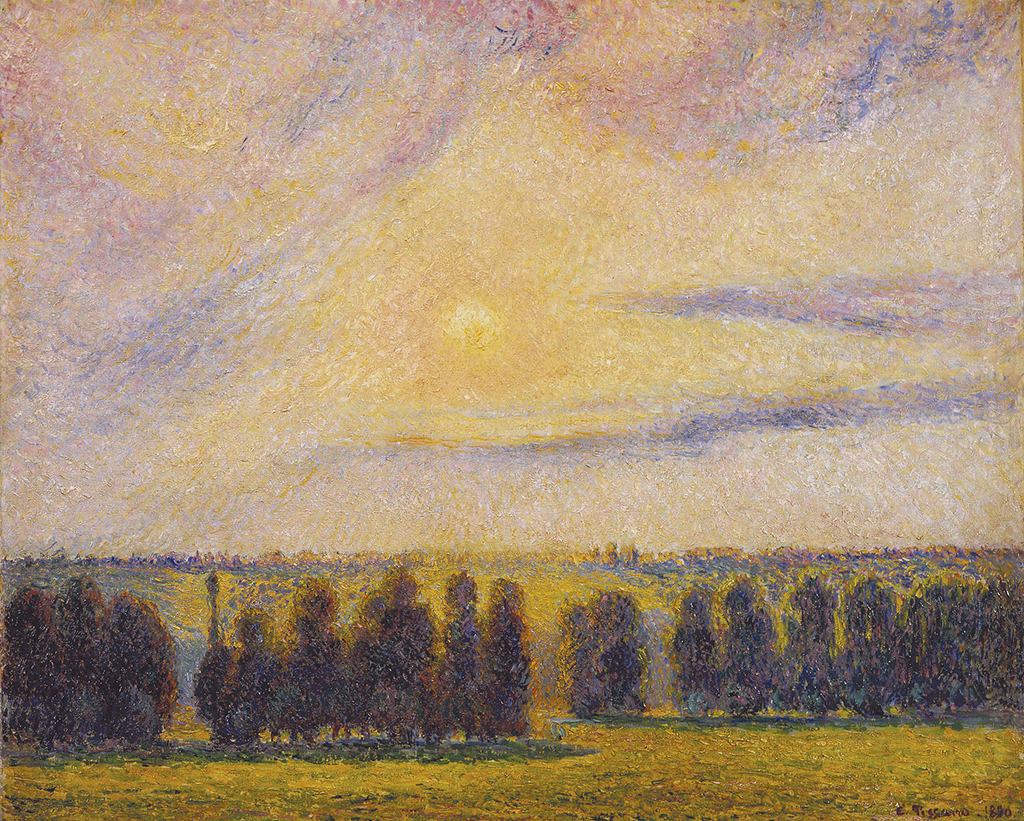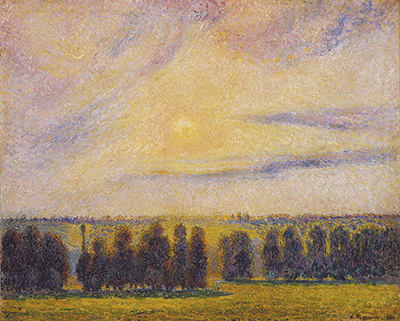Pissarro developed this painting at a time he was emerging from his experience with Neo-Impressionism. By then, he had resumed painting the outdoors by allowing freshly applied colours to interact on the surface instead of waiting for spots of different colours to dry separately.
Pissarro had just moved to Eragny and had rented a house that he later purchased and converted into a studio. It was here that Camille spent the last twenty years of his life. Eragny was more pastoral than Pontoise, where he had developed an interest in painting the outdoors. These new surroundings motivated him to paint the local landscapes with trees as the primary subject. In this particular piece, Pissarro sought to capture a moment that would soon disappear, i.e., the sunset. (See also Monet's sunset).
Pissarro was emphatic on the sky which occupied up to two-thirds of the surface of this painting. While this piece comprises a few elements, it brought out an incredible vibrancy. There are two rows of trees; he sets one row further back and divides it into four groups arranged horizontally across the surface. Behind the trees is a sloping ground that rises to meet the sky on a low horizon.
Style
Sunset at Eragny painting was one of Pissarro's late landscape pieces. During this period, Pissarro had become extremely dissatisfied with Impressionist painting methods and procedures and was already experimenting with diagonally parallel brushstrokes. In 1885, he met Georges Seurat who introduced him to the scientific (Neo-Impressionist) painting technique called the Pointillist. This painting technique was somewhat time-consuming as it involved the application of small, distinct dots of colour in different patterns to form images. What's more, it relied on the viewer’s ability to blend the colour spots into visible tones.
Though he later neglected Pointillism technique for a more natural approach, he borrowed a great deal when he was creating the Sunset at Eragny painting. The small, fragmented, and crisscrossed strokes blended with luminous colour contrasts bear witness to lessons learnt from this technique. He uses scattered pastel shades to showcase the setting sun while the golden light of the setting sun lights up the field.
However, Pissarro uses a dark green shade with violet and orange-tinged shadows to represent the trees. The rays of the sun touch only some parts of the trees. The actual colour of the trees is shown in the horizontal shades cast in front of them. The contrasting colours are brought to life by the dynamic and unique brushwork, which was rapid and accurate.
Related Painting - La Récolte des Foins, Eragny, 1887
This piece adds to the four paintings Pissarro developed during the Neo-Impressionism period. It showcases a hay harvesting season in Eragny. At the centre of the picture, is a woman using a hayfork to pile the hay while other workers work behind her in a brightly lit field. A unique feature of Pissarro's Neo-Impressionist paintings was his emphasis on rural life; he showcased using colourful hues and tones.





